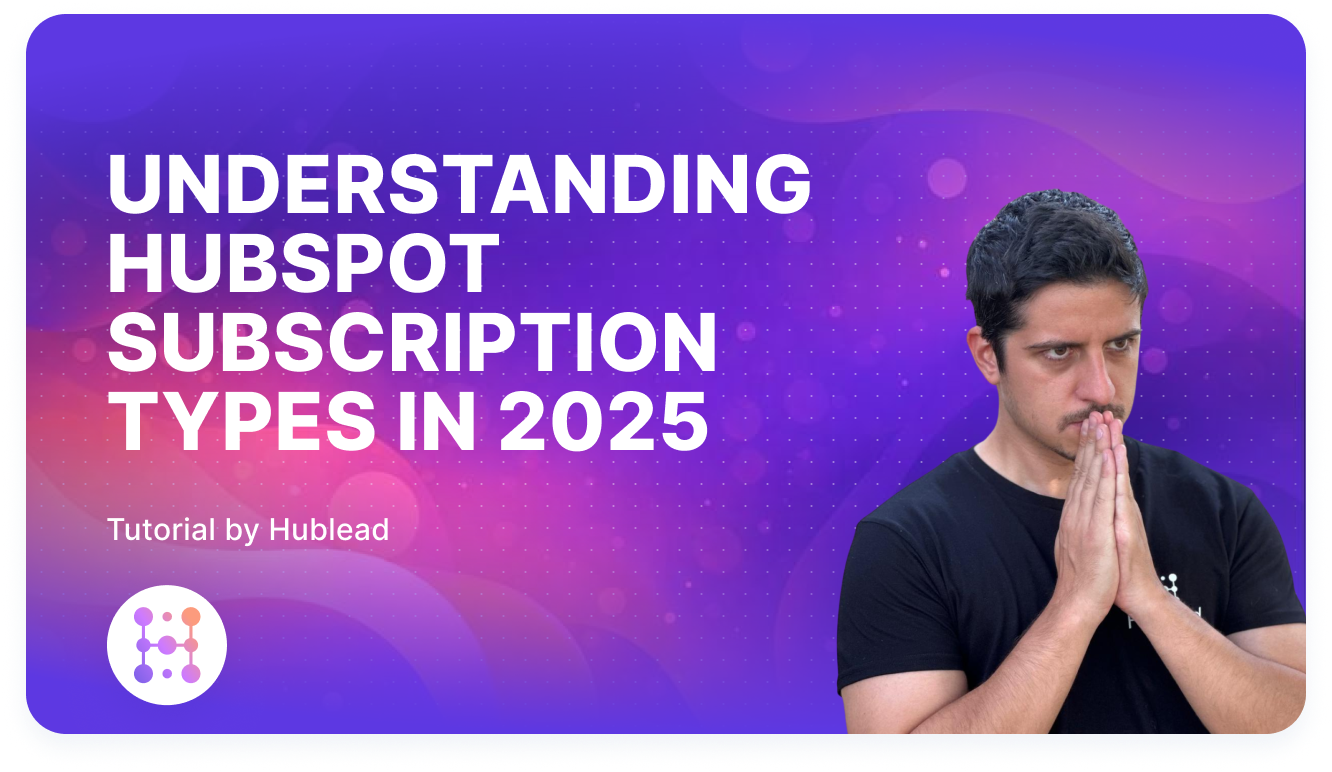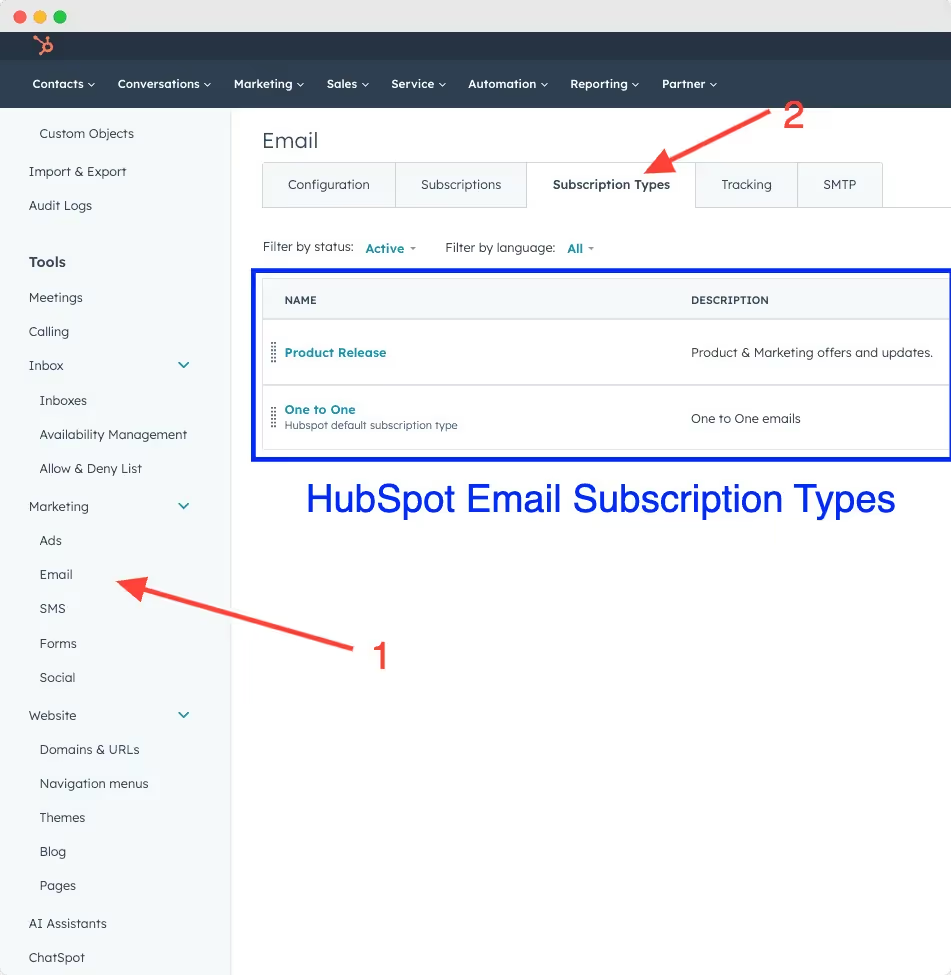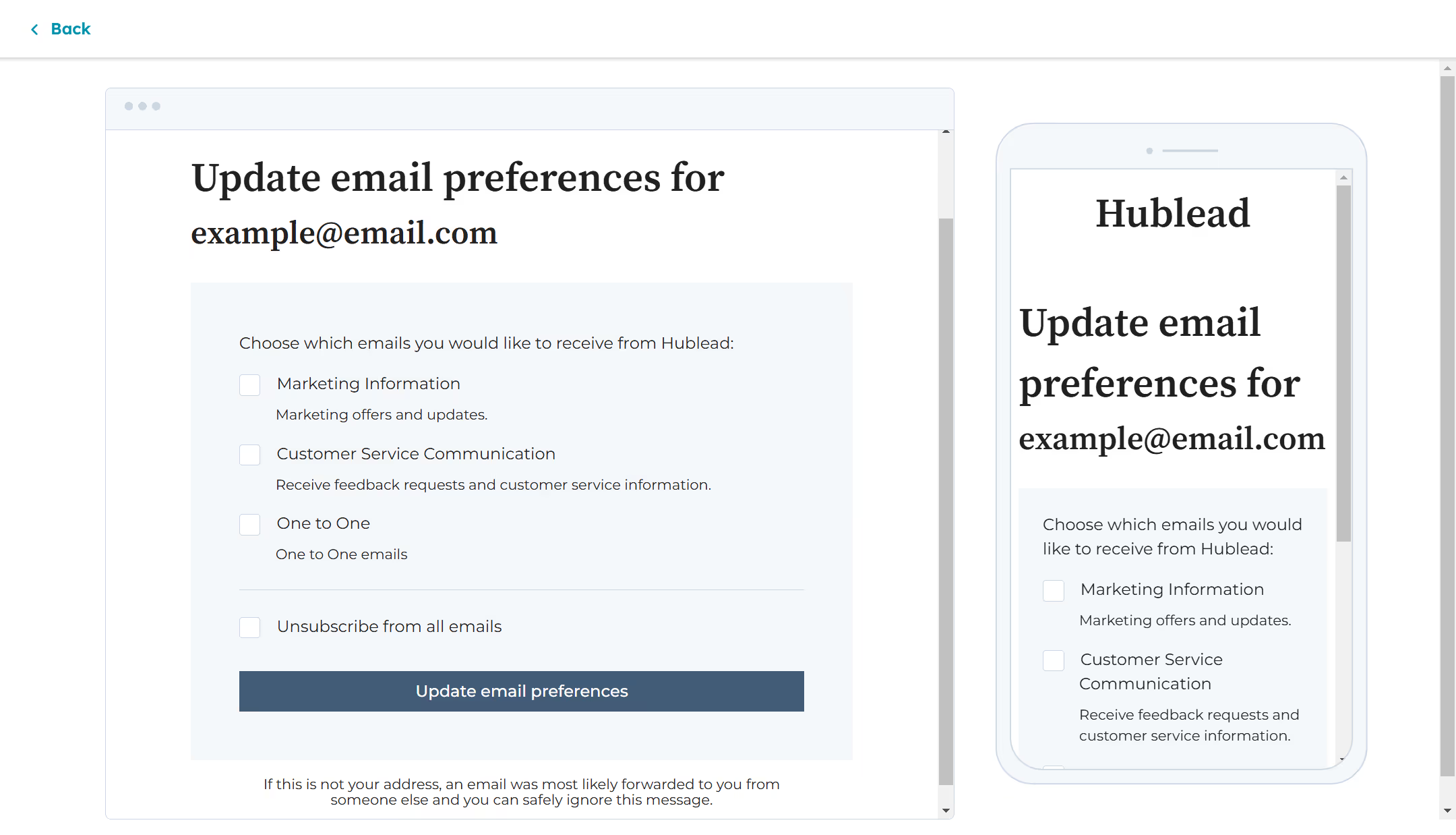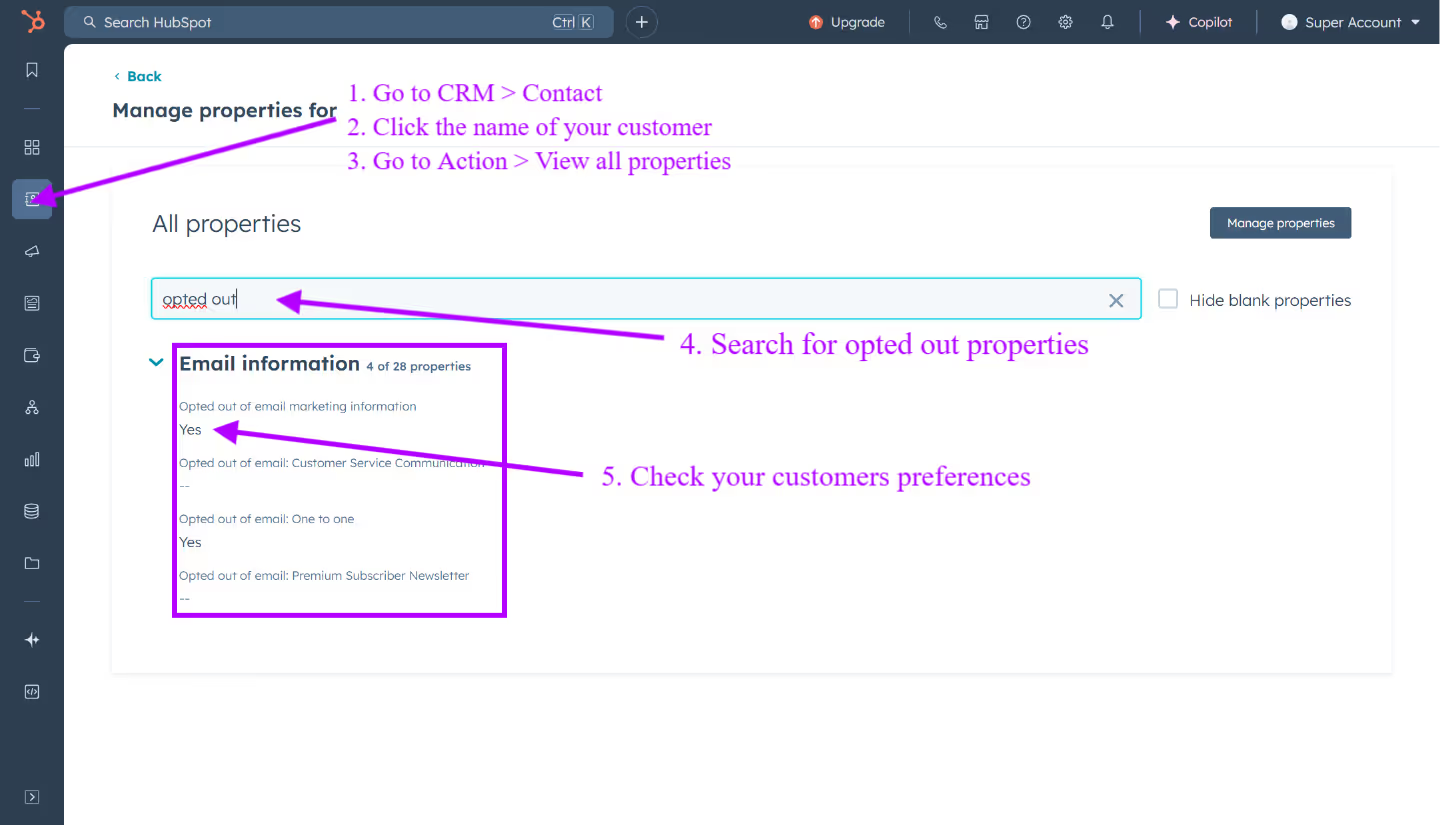Understanding HubSpot Subscription Types in 2025
Learn how subscription types work and how you can use them in your HubSpot account.

In today’s digital marketing landscape, managing communication, engaging audiences, and ensuring data compliance are essential. HubSpot subscription types streamline email organization, honor preferences, and deliver relevant content.
This guide explores the power of HubSpot subscription types and how to optimize them for your business.
Key Takeaways
- HubSpot subscription types let you tailor emails to audience preferences, boosting engagement and reducing unsubscribes.
- Managing subscription preferences ensures legal compliance and builds trust through transparency.
- Regular audits and analytics improve your email marketing strategy, driving better engagement and conversions.
What are HubSpot subscription types?
It helps you sort your emails into different buckets. Think of them like labels that tell you what each email is for—like product release, One to One communication, or newsletter.
You can find them in "Settings" > "Email" > "Subscription Types" like in this screenshot below.

So, if someone signs up for just your monthly newsletter, they won't get bombarded with all your other emails. Plus, you can create language-specific email subscription types to cater to the localized preferences of your international audience.
Subscription types help you send emails that your audience cares about while also ensuring your business meets GDPR requirements by maintaining subscriber opt-in status.
Tip: You can use different subscription types for different audience based on the HubSpot Original Source or based on contact properties updated by sales using the HubSpot LinkedIn integration.
Subscription Types vs. Lists
Both subscription types and lists play unique yet complementary roles in your email marketing strategy. Here’s how they differ:
- Subscription Types: Define the nature of your communication and manage consent. They answer the “what” of your email campaigns (e.g., “Monthly Newsletter” or “Product Updates”).
- Lists: Organize your contacts into groups based on shared traits or behaviors. They answer the “who” of your campaigns (e.g., a list of marketing contacts interested in sustainability).

By using these tools together, you can craft highly personalized and impactful campaigns. For instance, pairing a subscription type for "Industry News" with a list of contacts filtered by location allows you to send region-specific updates to interested subscribers.
Good to Know: Dynamic lists automatically update as contact properties change, keeping your audience segmentation current and making them ideal for use in workflows to ensure precise targeting.
When to Use Which
Use lists to segment your audience and target those most likely to engage with specific content or campaigns. They are perfect for automations and workflows, allowing you to organize contacts based on detailed properties.
On the other hand, subscription types focus on managing email consent and enabling users to check their subscription status. They ensure that existing contacts receive only the communications they’ve agreed to, which is essential for GDPR compliance.
How to use Subscription Types
Ensure GDPR Compliance
HubSpot's subscription types simplify GDPR compliance by acting as a legal safeguard. Each subscriber gets a personal webpage to update their preferences, ensuring email campaigns respect consent and data protection laws.

Tailor to Your Needs
Customize subscription types for newsletters, webinars, or product updates to fit your communication strategy. HubSpot supports up to 1,000 types, scaling with your business unit and allowing personalization within your CRM plan’s limits.
Hubspot Default Subscription Types
HubSpot’s default subscription types are designed to meet essential communication needs, providing a strong foundation for businesses to manage their email interactions effectively. Here’s a closer look at the two key default subscription types:
Customer Service Communication
This subscription type focuses on improving user experience and service quality. Subscribers receive communication designed to address their needs, including post-interaction feedback requests to refine services and updates on crucial changes like support hours, new service channels, or system modifications.
One-to-One Communication
A uniquely personal subscription type, ideal for delivering tailored messages directly to individuals based on where they are in the funnel. It facilitates personalized sales pitches, account manager follow-ups, or responses to specific inquiries, ensuring recipients receive targeted and meaningful communication that fosters strong, one-on-one connections beyond generic marketing.
HubSpot Common Custom Subscriptions Types
While HubSpot's default subscription types provide a strong foundation, custom subscription types allow businesses to refine their email communications for greater precision and engagement. Here are some popular custom subscription types you can implement:
- Marketing Information Subscriptions : Ideal for sharing promotional and informational content, this type keeps your audience informed about your latest products, services, and updates. Subscribers who opt in are often keen on staying updated with your company's offerings.
- Blog Subscriptions : Perfect for blog enthusiasts, this subscription notifies readers whenever new content is published. HubSpot provides flexible frequency options, including instant, daily, or weekly digests, to suit audience preferences.
- Event Notifications : Designed for businesses hosting webinars, conferences, or events, this subscription keeps attendees informed with timely updates and reminders about events they've expressed interest in.
- Product Updates : Especially beneficial for SaaS companies and businesses with frequent feature releases, this subscription ensures your customers stay informed about the latest product developments, enhancements, or changes.
- Newsletter Subscriptions : A go-to choice for most businesses, newsletters keep your audience engaged with periodic updates, stories, and curated content. It's an effective way to maintain a connection with a broad audience.
- Transactional Emails : While not typically subscription-based, transactional emails are triggered by user actions, such as purchases or webinar registrations. They play a vital role in business operations and user interactions.
- Feedback and Surveys : This type allows businesses to gather essential customer insights. Subscribers can receive surveys, feedback forms, or polls to share their experiences, helping businesses improve their offerings.
How to Set Up Subscription Types

Getting started with HubSpot subscription types is straightforward:
- Log in to your HubSpot account, go to Settings > Marketing > Email.
- Click the Create Subscription Type and fill out the necessary details:
- Name: Provide a clear title for the subscription type.
- Description: Briefly explain what kind of emails the subscriber will receive.
- Purpose and Method: Specify why and how you’ll communicate with the audience (important for GDPR compliance).
- Once configured, save your subscription type, and it will appear in your list.
Good to know : For an international audience, use translation features to offer email subscription types in multiple languages based on browser language, ensuring every subscriber feels valued.
Editing an Existing Subscription Type
In the dynamic world of digital marketing, adapting your email subscription types to align with evolving needs is essential. HubSpot simplifies the process, allowing you to make updates effortlessly:
- Log in to your HubSpot account and click the settings icon.
- Navigate to Marketing > Email in the left sidebar menu.
- Select the Subscription Types tab.
- Hover over the subscription type you want to update and click the Edit option.
- Make changes to the name, description, or other details to keep your subscriptions relevant.
- Save your updates to apply the changes.
Regularly reviewing and refining your subscription types ensures your communications remain aligned with both your business goals and your audience's preferences.

Navigating HubSpot Subscription Preferences
HubSpot makes managing subscriptions a seamless experience, offering a user-friendly interface that lets you take control of your email marketing strategy. By mastering these settings, you can boost engagement and strengthen connections with your audience.
Checking a Contact's Subscription Status
Curious if a colleague or customer is tuned into your latest updates? HubSpot makes it simple. Just navigate to Contacts, click on the individual you're curious about, and check the Communication subscriptions section. In moments, you'll see if they’re Subscribed, Unsubscribed, or if their preference is Not specified. It’s a quick, effortless way to stay informed.

The Power of the Communication Subscriptions Section
What might look like a small section in a contact’s profile is actually a treasure trove of insights. The Communication subscriptions tab isn’t just about statuses—it’s a tool for crafting smarter campaigns. With clear data on preferences, you can tailor messages for maximum impact while respecting contact choices.
GDPR and HubSpot Subscriptions
Adhering to GDPR and similar data protection regulations is essential in today’s landscape of online communication. HubSpot integrates GDPR principles directly into its subscription types, making compliance straightforward and efficient. By categorizing contacts into three subscription statuses, it ensures businesses can manage email communication responsibly while safeguarding user privacy:
- Opted In: Contacts who have explicitly consented to receive specific email communications, aligning with GDPR's transparency requirements.
- Not Opted In or Out: The default status for contacts who haven’t provided explicit consent, ensuring no unsolicited communication takes place. Make sure to ask explicit consent before sending emails to them.
- Opted Out: Contacts who have chosen to unsubscribe, emphasizing respect for user preferences and data protection laws.
HubSpot's GDPR-enabled tools allow businesses to stay compliant while maintaining trust, ensuring email campaigns are not only effective but also legally sound.
Tip: Run a permission pass campaign to nudge contacts with “Not Opted In” status to update their email preferences and gain explicit consent for specific subscription types.
Subscription Type Best Practices
Auto-Creation of Opted-Out Properties

HubSpot automatically creates an "Opted out of email: [Email Subscription Type]" contact property for every new subscription type. This feature simplifies managing contact properties by providing instant visibility into opt-out preferences on contact records, ensuring compliance with email consent standards and streamlining subscription management.
Engaging Contacts Effectively
Optimize subscription types to boost email marketing results:
- Personalization: Tailor subscription types to audience segments, like "Weekly Tips" for learners or "Event Updates" for attendees.
- Transparency: Use clear descriptions to help contacts make informed choices.
- Regular Audits: Conduct regular data audits to keep contact information relevant and updated and to ensure subscription types remain aligned with audience needs and .
Example: Leverage the communication subscriptions section to monitor statuses and refine outreach, ensuring targeted and effective engagement.
These practices enhance personalization, compliance, and overall email strategy efficiency.
Leveraging Subscription Types for Growth
Here’s how HubSpot subscription types can enhance your email marketing strategy:
- Boost Engagement: By letting only marketing contacts choose specific emails, you reduce opt-outs and increase engagement.
- Improve Targeting: Combine subscription types with lists to send hyper-targeted marketing emails to only marketing contacts.
- Foster Trust: A transparent subscription preferences page builds credibility and encourages only marketing contacts to stay connected.
Example: A custom subscription type for "Exclusive Deals" can boost conversions among price-sensitive customers, while "Industry News" nurtures thought leadership.
The Future of Subscription Types in Digital Marketing
As digital marketing evolves, so do the opportunities to leverage tools like HubSpot's subscription types. The key is to adapt these features to meet both your business goals and your audience’s expectations. Here’s how to stay ahead:
- Embrace Analytics: Use HubSpot’s reporting tools to conduct in-depth analysis of subscription type performance.
- Focus on Experience: Optimize the subscription preferences page for ease of use and clarity.
- Expand Globally: Cater to international audiences with multilingual email subscriptions and localized content.
Conclusion
HubSpot's subscription types are more than just a tool—they’re a strategy. By categorizing your email communications, respecting subscription preferences, and maintaining compliance, you can create campaigns that resonate with your audience and achieve your business objectives.
Start optimizing your strategy today and see the difference it makes in your email marketing efforts!
Frequently Asked Questions
What is a HubSpot subscription type?
A HubSpot subscription type categorizes emails, like newsletters or product updates, to tailor communication, manage consent, and meet GDPR compliance. It ensures subscribers only receive emails they’ve opted into, boosting engagement and trust.
How do email subscription types differ from lists in HubSpot?
Subscription types define the "what" (e.g., "Monthly Newsletter"), while lists focus on the "who" by segmenting contacts. Combining both enables precise, personalized campaigns.
What is the difference between unsubscribe and opt-out in HubSpot?
Unsubscribe removes contacts from specific emails, while opt-out blocks all emails, including marketing and one-to-one. Both can be managed manually or via lists.
How do HubSpot subscription types support GDPR compliance?
Subscription types categorize contacts as Opted In, Not Opted In or Out, and Opted Out. This ensures only consenting marketing contacts receive emails, meeting GDPR standards.
Why is opt-out good?
It gives users control over their data and to choose if they want to share it. At the same time, it is important to have an opt-out in case you want to give users the right to withdraw or change their consent.
